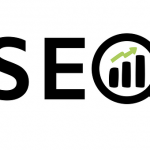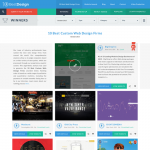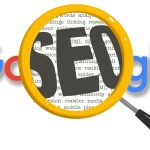How to Get Your SaaS Website on the First Page of Google
In the highly competitive world of Software as a Service (SaaS), achieving a prominent position on the first page of Google search results is a game-changer. Why? Because studies have shown that the first page of Google captures around 71% of search traffic, and the majority of users rarely venture beyond that. So, how can you ensure your SaaS website lands on that coveted first page? Here’s a comprehensive guide to help you get there.
Post Contents
1. In-Depth Keyword Research
The journey to the first page of Google begins with meticulous keyword research. Start by identifying keywords and phrases that are not only relevant to your SaaS solution but also have a reasonable search volume and manageable competition. Tools like Google Keyword Planner, SEMrush, and Ahrefs can be invaluable for this purpose.
Consider both short-tail and long-tail keywords. Short-tail keywords are broad and highly competitive, while long-tail keywords are more specific and can be easier to rank for. Your goal is to find a balance between relevance and attainability.
2. On-Page SEO Optimization
Optimizing your SaaS website’s on-page elements is fundamental to securing a position on the first page of Google. Start with your title tags, meta descriptions, header tags (H1, H2, H3, etc.), and URLs. Integrate your chosen keywords naturally into these elements to make them search-engine-friendly.
Ensure that your website is mobile-responsive. Google gives preference to mobile-friendly sites, so responsive design is not just a recommendation but a requirement.
3. Create High-Quality Content
Content is the lifeblood of your SEO strategy. Produce high-quality, valuable content that addresses the pain points and questions of your target audience seo for saas companies. This content can come in various formats, including blog posts, whitepapers, eBooks, case studies, and videos.
The key is to establish your SaaS company as an authority in your niche. Content should provide solutions, insights, and knowledge that resonate with your audience. High-quality content is more likely to be shared on social media and attract backlinks, both of which are SEO gold.
4. Leverage Video Marketing
Video content is a dynamic tool for enhancing your SEO and website visibility. It’s engaging, shareable, and highly accessible. Utilize video content to showcase your SaaS solution’s features, customer success stories, and informational guides.
Optimize your videos by including relevant keywords in titles and descriptions to improve pay per click management services. Adding transcriptions and closed captions not only improves accessibility but also provides more textual content for search engines to index.
5. Technical SEO Best Practices
Technical SEO forms the backbone of your website’s search engine performance. Ensure that your website loads quickly, provides a seamless user experience, and adheres to the best practices for technical optimization.
This includes monitoring site speed, mobile-friendliness, and ensuring your website is secure with an SSL certificate. Additionally, fix any broken links or redirects, which can negatively affect user experience and SEO rankings. Use a sitemap to help search engines index your pages efficiently.
6. Building a Strong Backlink Profile
Backlinks, or links from other websites to yours, are vital signals that your content is valuable and authoritative. Develop a backlink acquisition strategy that includes guest posting on relevant websites, forming partnerships with influencers, and engaging in content marketing.
Quality always trumps quantity when it comes to backlinks. Focus on acquiring links from authoritative sources within your industry. A diverse and high-quality backlink profile is a significant factor in improving search engine rankings.
7. Local SEO for SaaS Companies
If your SaaS company serves specific geographic areas, local SEO is a must. Optimize your Google My Business listing, create location-specific landing pages, and encourage customer reviews. Local SEO ensures that your target audience can find you when searching for SaaS solutions in their vicinity.
8. Monitoring and Continuous Improvement
SEO is an ongoing process. It’s essential to continually monitor and analyze your website’s performance. Tools like Google Analytics and Google Search Console provide valuable insights into your website’s traffic, user behavior, and keyword performance.
Regularly review these metrics to determine what’s working and what needs improvement. Adjust your strategy based on the data you collect to ensure your SEO efforts remain effective.
9. Stay Informed and Adapt
The SEO landscape is continually evolving, with search engines frequently updating their algorithms. To keep your SaaS website on the first page of Google, it’s crucial to stay informed about the latest trends and adapt your strategy accordingly.
Invest in SEO tools and analytics to streamline your efforts and make data-driven decisions. Engage with industry forums, follow SEO news, and attend webinars to stay up-to-date with the latest developments.
10. Patience and Persistence
Reaching the first page of Google is not an overnight feat. It takes time, persistence, and ongoing effort. SEO is a long-term strategy that requires consistent work and adaptation to stay relevant and competitive in the ever-changing digital landscape.
In conclusion, landing your SaaS website on the first page of Google is an achievable goal with the right SEO strategies in place. This comprehensive guide covers the essential steps, from keyword research and on-page optimization to content creation, video marketing, technical SEO, backlink building, local SEO, and continuous improvement. By following these steps and staying informed about industry changes, your SaaS business can significantly increase its online visibility and attract a broader audience, ultimately positioning your website on the coveted first page of Google’s search results.
Next PagePrevious Page








![What Is Web Hosting? [A Guide]](https://moravita.com/wp-content/uploads/2022/12/webhosting-150x150.jpg)
Social Media Icons